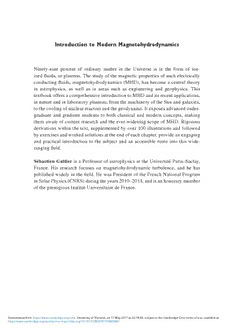
Introduction to Modern Magnetohydrodynamics PDF
Preview Introduction to Modern Magnetohydrodynamics
Introduction to Modern Magnetohydrodynamics Ninety-nine percent of ordinary matter in the Universe is in the form of ion- izedfluids,orplasmas.Thestudyofthemagneticpropertiesofsuchelectrically conducting fluids, magnetohydrodynamics (MHD), has become a central theory in astrophysics, as well as in areas such as engineering and geophysics. This textbookoffersacomprehensiveintroductiontoMHDanditsrecentapplications, innatureandinlaboratoryplasmas;fromthemachineryoftheSunandgalaxies, tothecoolingofnuclearreactorsandthegeodynamo.Itexposesadvancedunder- graduate and graduate students to both classical and modern concepts, making them aware of current research and the ever-widening scope of MHD. Rigorous derivations within the text, supplemented by over 100 illustrations and followed byexercisesandworkedsolutionsattheendofeachchapter,provideanengaging and practical introduction to the subject and an accessible route into this wide- rangingfield. Se´bastien Galtier is a Professor of astrophysics at the Universite´ Paris–Saclay, France. His research focuses on magnetohydrodynamic turbulence, and he has published widely in the field. He was President of the French National Program inSolarPhysics(CNRS)duringtheyears2010–2014,andisanhonorarymember oftheprestigiousInstitutUniversitairedeFrance. Downloaded from https:/www.cambridge.org/core. University of Warwick, on 17 May 2017 at 22:19:43, subject to the Cambridge Core terms of use, available at https:/www.cambridge.org/core/terms. https://doi.org/10.1017/CBO9781316665961 Downloaded from https:/www.cambridge.org/core. University of Warwick, on 17 May 2017 at 22:19:43, subject to the Cambridge Core terms of use, available at https:/www.cambridge.org/core/terms. https://doi.org/10.1017/CBO9781316665961 Introduction to Modern Magnetohydrodynamics Se´bastien Galtier Universite´ Paris–Saclay Downloaded from https:/www.cambridge.org/core. University of Warwick, on 17 May 2017 at 22:19:43, subject to the Cambridge Core terms of use, available at https:/www.cambridge.org/core/terms. https://doi.org/10.1017/CBO9781316665961 UniversityPrintingHouse,CambridgeCB28BS,UnitedKingdom CambridgeUniversityPressispartoftheUniversityofCambridge. ItfurtherstheUniversity’smissionbydisseminatingknowledgeinthepursuitof education,learningandresearchatthehighestinternationallevelsofexcellence. www.cambridge.org Informationonthistitle:www.cambridge.org/9781107158658 ©EditionsVuibert–Paris2013 Englishtranslation©Se´bastienGaltier2016 Thispublicationisincopyright.Subjecttostatutoryexception andtotheprovisionsofrelevantcollectivelicensingagreements, noreproductionofanypartmaytakeplacewithoutthewritten permissionofCambridgeUniversityPress. Firstpublished2013asMagne´tohydrodynamique–Desplasmasdelaboratoirea`l’astrophysique UpdatedEnglisheditionpublished2016 PrintedintheUnitedKingdombyTJInternationalLtd.PadstowCornwall AcatalogrecordforthispublicationisavailablefromtheBritishLibrary LibraryofCongressCataloging-in-Publicationdata Names:Galtier,Se´bastien,author. Title:Introductiontomodernmagnetohydrodynamics/Se´bastienGaltier, Universite´Paris–Saclay Description:Cambridge,UnitedKingdom;NewYork,NY:CambridgeUniversity Press,2016.|Includesbibliographicalreferencesandindex. Identifiers:LCCN2016014636|ISBN9781107158658(Hardback)|ISBN1107158656(Hardback) Subjects:LCSH:Magnetohydrodynamics. Classification:LCCQC718.5.M36G352016|DDC538/.6–dc23LCrecordavailableat https://lccn.loc.gov/2016014636 ISBN978-1-107-15865-8Hardback CambridgeUniversityPresshasnoresponsibilityforthepersistenceoraccuracy ofURLsforexternalorthird-partyinternetwebsitesreferredtointhispublication, anddoesnotguaranteethatanycontentonsuchwebsitesis,orwillremain, accurateorappropriate. Downloaded from https:/www.cambridge.org/core. University of Warwick, on 17 May 2017 at 22:19:43, subject to the Cambridge Core terms of use, available at https:/www.cambridge.org/core/terms. https://doi.org/10.1017/CBO9781316665961 Tomyfamily Downloaded from https:/www.cambridge.org/core. University of Warwick, on 17 May 2017 at 22:21:53, subject to the Cambridge Core terms of use, available at https:/www.cambridge.org/core/terms. https://doi.org/10.1017/CBO9781316665961 Downloaded from https:/www.cambridge.org/core. University of Warwick, on 17 May 2017 at 22:21:53, subject to the Cambridge Core terms of use, available at https:/www.cambridge.org/core/terms. https://doi.org/10.1017/CBO9781316665961 Contents Preface pagexiii TableofPhysicalQuantities xv PartI Foundations 1 1 Introduction 3 1.1 SpaceandLaboratoryPlasmaPhysics 3 1.2 WhatIsaPlasma? 7 1.3 KineticDescription 9 1.3.1 CollisionlessPlasma 10 1.3.2 PlasmawithCollisions 11 1.3.3 Non-linearities 12 1.4 TimeScalesandLengthScales 13 1.4.1 PlasmaOscillations 13 1.4.2 ElectricScreening 14 1.4.3 MagneticScreening 15 1.4.4 Cyclotronfrequency 16 1.5 FromKinetictoFluids 17 1.5.1 Multi-fluidEquations 17 1.5.2 Mono-fluidEquations 18 2 Magnetohydrodynamics 19 2.1 Introduction 19 2.1.1 ElectromagneticInduction 19 2.1.2 ExtensiontoConductingFluids 21 vii Downloaded from https:/www.cambridge.org/core. University of Warwick, on 17 May 2017 at 22:17:54, subject to the Cambridge Core terms of use, available at https:/www.cambridge.org/core/terms. https://doi.org/10.1017/CBO9781316665961 viii Contents 2.2 TowardsaFormulationofMHD 21 2.2.1 Maxwell’sEquations 21 2.2.2 GeneralizedOhm’sLaw 23 2.3 Quasi-neutrality 24 2.4 Generalized(Hall)MHDEquations 25 2.4.1 TheIncompressibleLimit 27 2.4.2 ElectronMHD 28 2.4.3 IdealMHD 28 2.5 ExamplesofElectricallyConductingFluids 29 3 Conservation Laws 32 3.1 Mass 32 3.2 Momentum 33 3.3 Energy 34 3.4 Cross-helicity 36 3.5 MagneticHelicity 38 3.6 Alfve´n’sTheorem 39 3.6.1 MagneticFluxConservation 39 3.6.2 Kelvin’sTheorem 40 3.6.3 Alfve´n’sTheorem 41 3.7 MagneticTopology 42 3.8 TopologyatSub-ionScales 45 ExercisesforPartI 47 PartII FundamentalProcesses 49 4 Magnetohydrodynamic Waves 51 4.1 MagneticTension 51 4.2 Alfve´nWaves 53 4.3 MagnetosonicWaves 55 4.4 Whistler,Ion-Cyclotron,andKineticAlfve´nWaves 58 4.4.1 IncompressibleHelicalWaves 58 4.4.2 CompressibleHallMHDWaves 61 5 Dynamos 65 5.1 Geophysics,Astrophysics,andExperiments 65 5.1.1 ExperimentalDynamos 65 5.1.2 NaturalDynamos 70 Downloaded from https:/www.cambridge.org/core. University of Warwick, on 17 May 2017 at 22:17:54, subject to the Cambridge Core terms of use, available at https:/www.cambridge.org/core/terms. https://doi.org/10.1017/CBO9781316665961 Contents ix 5.2 TheCriticalMagneticReynoldsNumber 73 5.3 TheKinematicRegime 74 5.4 Anti-dynamoTheorems 76 5.5 ThePonomarenkoDynamo 79 5.6 TheTurbulentDynamo 83 5.6.1 KinematicMeanFieldTheory 83 5.6.2 Theα-effect 84 5.7 Conclusion 85 6 Discontinuities and Shocks 86 6.1 Rankine–HugoniotConditions 86 6.2 Discontinuities 91 6.2.1 TangentialandContactDiscontinuities 92 6.2.2 RotationalDiscontinuity 92 6.3 Shocks 94 6.3.1 IntermediateShocks 94 6.3.2 TrueShock 94 6.4 CollisionlessShocks 94 7 Magnetic Reconnection 96 7.1 ACurrentSheetinIdealMHD 96 7.2 TheSweet–ParkerModel 99 7.3 CollisionlessHallMHDReconnection 103 7.4 Perspectives 104 ExercisesforPartII 107 PartIII InstabilitiesandMagneticConfinement 111 8 Static Equilibrium 113 8.1 EquilibriumEquations 113 8.2 MagneticConfinementbyθ-Pinch 114 8.3 MagneticConfinementbyz-Pinch 116 8.4 ToroidalTokamakConfiguration 117 8.4.1 TheGrad–ShafranovEquation 118 8.4.2 TheSolovievExactSolution 121 8.5 Force-FreeFields 122 Downloaded from https:/www.cambridge.org/core. University of Warwick, on 17 May 2017 at 22:17:54, subject to the Cambridge Core terms of use, available at https:/www.cambridge.org/core/terms. https://doi.org/10.1017/CBO9781316665961 x Contents 9 Linear Perturbation Theory 125 9.1 Instabilities 125 9.1.1 Classification 125 9.1.2 ConditionofExistence 126 9.2 KineticVersusFluid 127 9.2.1 TheKineticApproach 127 9.2.2 TheFluidApproach 128 9.3 TheEnergyStabilityCriterion 129 9.3.1 AOne-DimensionalExample 129 9.3.2 Two-DimensionalExamples 131 9.3.3 TheMHDCase 132 9.4 PerturbationTheory 133 9.4.1 TheSmall-DisplacementOperator 133 9.4.2 SolutiontoInitialValues 135 9.4.3 TheEquationoftheNormalModes 136 9.4.4 PropertiesoftheOperatorF 136 9.4.5 TheReturnontheEnergyIntegral 138 10 Study of MHD Instabilities 139 10.1 StabilityofMHDWaves 139 10.1.1 Alfve´nWaves 140 10.1.2 MagnetosonicWaves 141 10.2 Rayleigh–TaylorInstability 143 10.2.1 TheFirstMethod:EnergyIntegrals 143 10.2.2 TheSecondMethod:NormalModes 144 10.3 Kruskal–SchwarzschildInstability 146 10.4 z-PinchInstability 152 10.4.1 StaticEquilibrium 152 10.4.2 InstabilityModes 154 10.4.3 ResolutionbyNormalModes(Casem = 0) 155 10.4.4 Configurationm = 1 160 10.5 z–θ PinchInstability 160 10.6 Magneto-rotationalInstabilityinAccretionDisks 161 ExerciseforPartIII 168 Downloaded from https:/www.cambridge.org/core. University of Warwick, on 17 May 2017 at 22:17:54, subject to the Cambridge Core terms of use, available at https:/www.cambridge.org/core/terms. https://doi.org/10.1017/CBO9781316665961
